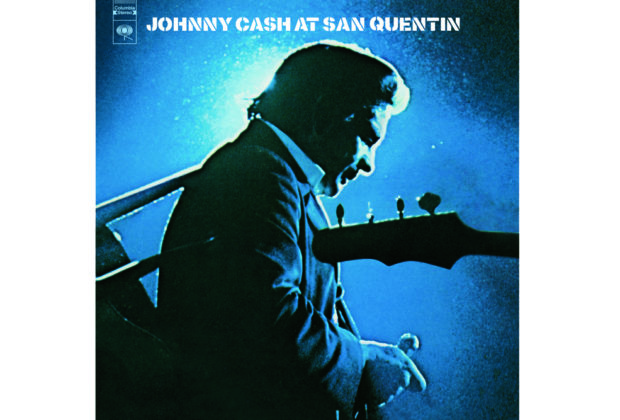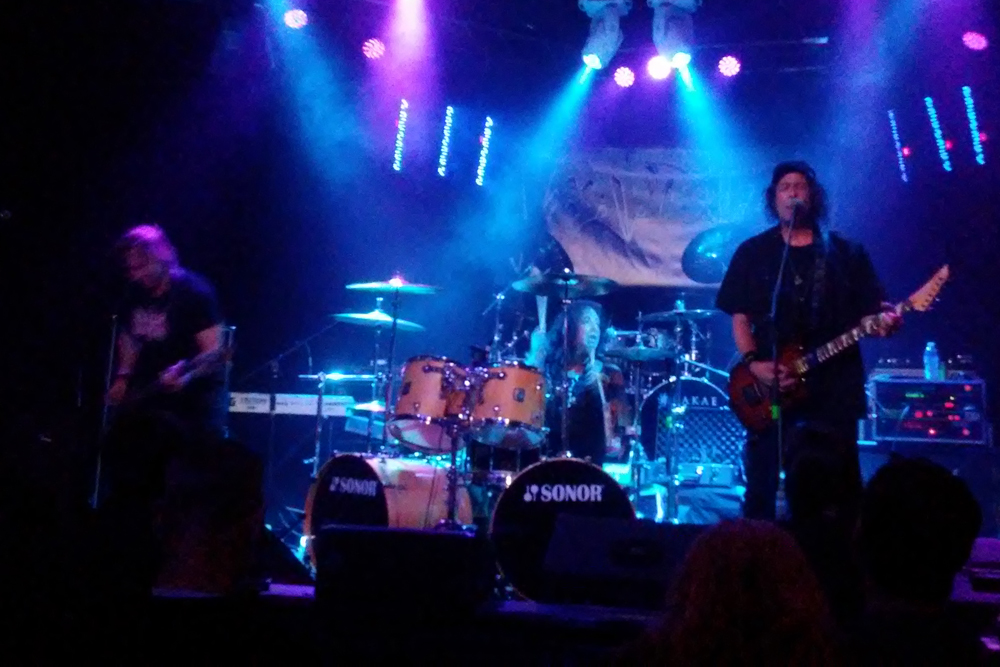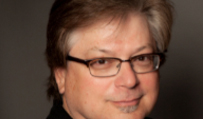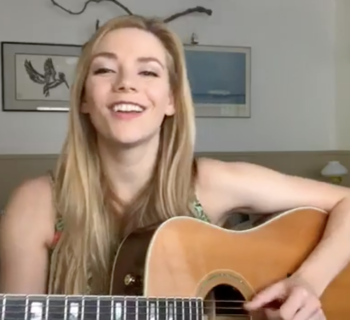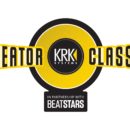Johnny Cash Live At San Quentin album, Johnny Cash song “A Boy Named Sue” and The Johnny Cash Show television series are all about to observe their 50th anniversary.
A new documentary on Johnny Cash, The Gift: The Journey of Johnny Cash will have its premier at SXSW in Austin, Texas March 9.
Director Thom Zimny who helmed Elvis Presley: The Searcher examines the live recording Cash and his band did in 1968 at Folsom Prison in California.
That event serves as a central motif of the movie and features interviews with family and celebrated collaborators, “while the liner narrative of the Folsom Prison performances will anchor our film, each song in the set list will open a door into a nonlinear presentation of Cash’s emotional, musical and personal development,” said co-producer Zimny on johnnycashonline.com.
John Carter Cash, Frank Marshall, Ryan Suffern and Jeff Pollack are among the film’s Executive Producers. Screenwriter is Warren Zanes. Mike McCready of Pearl Jam supplied the musical score.
"A Boy Named Sue," written by humorist, poet, and singer/songwriter Shel Silverstein became a popular hit record during 1969 by Johnny Cash.
On February 24, 1969, two days before he turned 37, Cash recorded the song live in concert at California's San Quentin State Prison for his Johnny Cash At San Quentin album produced by Bob Johnston, issued on Columbia Records June 26, 1969.
Born Sheldon Allan "Shel" Silverstein in Chicago in 1930, Silverstein was known for his cartoons, songs, children’s books and contributions to Playboy magazine.
During 1969 Silverstein’s own recording of “Boy Named Sue,” a 45 RPM on the LP Boy Named Sue (And His other Country Songs),was produced by Chet Atkins and Felton Jarvis.
It has been said that Silverstein's inspiration for the song's title came from a man named Sue K. Hicks, who was a judge in the state of Tennessee. Silverstein heard Hicks speak at an event, and was intrigued by the name of Sue for a man. Apparently it was the father of Sue Hicks who named the boy after his mother, Susanna Hicks, who died during hospital birth.
Legend has it that Silverstein had penned the tune after a conversation with his friend Jean Shepherd, the writer, radio and television storyteller, who remarked about his own childhood dismay at being taunted for what many kids felt was a "girl's name."
Silverstein first introduced his copyright to Johnny and June Cash during a "Guitar Pull" at their Hendersonville Tennessee home where local and visiting musicians would pass a guitar around and play their recent songs.
Mitch Myers, Silverstein’s nephew, biographer, and Director of the Silverstein archives, emailed me in 2018 verifying that it was June Carter Cash who encouraged Johnny to include it in their stage show.
Canadian-based writer and Cash scholar Gary Pig Gold, in the September 11, 2009 Rock and Roll Report also provides additional information on how “A Boy Named Sue” landed in the Cash repertoire:
“It was quite common for JC to invite special televised Johnny Cash Show guests back to his grand new Hendersonville, TN homestead for post-taping song swaps. On any such evening the guitar would be passed round to, for example, Graham Nash (who offered ‘Marrakesh Express’), Kris Kristofferson (premiering ‘Me And Bobby McGee’), and of course Johnny’s ol’ pal the Zimmer Man (who, applying his grand new boudoir voice, crooned ‘Lay Lady Lay’).
“In fact one morning after, a young Rosanne Cash was flabbergasted to find none other than her teenage bedroom wall pin-up prince Davy Jones sitting at the breakfast table! (Yes, Johnny had hosted The Monkees on prime time just the night before).
“One most momentous evening however, the inimitable Shel Silverstein decided to test-drive a peculiar — even by Silverstein standards — new number he hadn’t even considered shopping across Music City just yet. Johnny wanted to hear it though:
“That’s the most cleverly written song I’ve ever heard” was the verdict minutes later, and luckily June thought enough to stuff Shel’s cheat sheet into her husband’s bag before they departed for the next day’s recording session over at San Quentin. ‘I didn’t even know the lyrics,” Johnny recalled of making his quickest, biggest hit. ‘I had to put the words on a music stand in front of me. I told ’em I wanted to sing a song called ‘A Boy Named Sue.’ Well they laughed, you know, and I said ‘No, it’s not what you think. Let me sing it to you.’ I read the lyrics off the paper in front of me, and that was the record.’
“And by late that summer, only those Rolling Stones and their honky tonk women could keep Sue off the very top of your local Top 40 Radio survey.”
Cash wrote in his autobiography Man In Black, that he had just received the song and only read over it a couple of times. It was incorporated in the prison concert just to try it out. On the filmed documentary of the event Johnny can be seen regularly referring to the paper lyric sheet.
Cash biographer, Robert Hilburn, JOHNNY CASH: The Life (Little, Brown and Company) confirmed as well that neither the British television crew filming the concert as well as his band knew he planned to include the song in his act while Carl Perkins and the musicians improvised backing on the spot.
The recording contained the lyric "I’m the son of a bitch that named you Sue!” It was subsequently edited out in the first product shipments on the single and the Johnny Cash At San Quentin album.
On subsequent re-orders, compilations and reissues, “son of a bitch" was modified to "son of a gun" or even bleeped out completely on some configurations for AM and FM radio airplay.
The live San Quentin version of the song became Cash's biggest hit on the Billboard Hot 100 chart and his only top ten single there, spending three weeks at No. 2 in 1969.
“A Boy Named Sue” topped the Billboard Hot Country Songs on September 16, 1969 and radio station KHJ in the Los Angeles market on their August 6, 1969 radio station survey.
Cash’s unplanned smash hit record was certified Gold by the RIAA on August 14, 1969. It also earned a Grammy for Silverstein in 1970 as best Country & Western Song.
Originally a single album, this century Johnny Cash At San Quentin is now a deluxe three-disc, Legacy Edition package: two CDs containing 31 selections, 13 of them previously unissued.
The package also houses a DVD, Johnny Cash In San Quentin, the culture-shaping 1969 documentary produced and directed by Mike Darlow for England’s Granada television network.
Journalist Geoffrey Cannon from The Guardian had pitched the idea to executives at Granada and eventually sold the concept to Cash’s manager, Saul Holiff.
The expanded Johnny Cash At San Quentin includes a full rendition of “A Boy Named Sue.” It’s a stirring portrait of Cash and band; the Statler brothers, lead guitarists Bob Wooten and Carl Perkins, bassist Marshall Grant, drummer WS Holland, June Carter and Carter family members. There are also interviews with the prisoners and guards who were in attendance when The Johnny Cash Show packed the big house.
Shel Silverstein’s tune and the fortuitous alignment with Johnny Cash has continued for half a century in magazines, movies and informed other songs by bands referencing it.
A 1970 issue of MAD magazine displayed a parody titled A Boy Named Lassie. A male character in the movie Swingers is named Sue, and another actor announced on screen, “His dad was a big Johnny Cash fan.” “A Boy Named Sue” is referenced in a lyric of the Red Hot Chili Peppers’ “One Big Mob.”
The Silverstein-penned song also inspired a 2004 book A Boy Named Sue: Gender and Country Music by Kristine M. McCusker which examines the impact of gender on the development of country music.
Silverstein’s own books have sold more than 20 million copies and his literary catalog has been translated into over 30 languages.
It was in June 1967 when Columbia Records staff producer Bob Johnston replaced Don Law at the Nashville based company producing Cash.
Johnston’s production acumen and label machinations on behalf of Cash in the 1968 and ’69 time period resulted in two California penitentiary location-dependent live recordings: Johnny Cash at San Quentin and Johnny Cash At Folsom Prison.
Johnston’s credits include Leonard Cohen’s Songs From a Room and Songs of Love and Hate, and Bob Dylan’s Highway 61 Revisited, Blonde On Blonde, John Wesley Harding, and Nashville Skyline. He worked on Simon & Garfunkel’s Bookends.
Johnston was born in 1932 in Hillsboro, Texas. His career began as a songwriter eventually holding a staff writing position at Elvis Presley’s Hill & Range Music and often reviewed potential Presley demos and songs earmarked for his movies in 1964 and 1965. Bob co-wrote with Charlie Daniels ‘It Hurts Me,’ the flip side of Presley’s hit “Kissin Cousins” before he joined Columbia Records in 1965.
I met Johnston and producer/label executive Jimmy Bowen in July 1978 at MCA Records on Lankershim Blvd. in Universal City when I was West Coast Director of A&R for the label. At the time Johnston was producing Joe Ely’s Down on the Drag. We went down the street to see Ely at the Palomino Club.
“When I took over Cash he didn’t hit the country charts,” declared Johnston in a 2007 interview with me. “Like I said on the back of the Folsom Prison album liner notes, no one for eight years would let him go there to record live until he got me, and I said, ‘let’s do it’ I picked up the phone and called Folsom and San Quentin,” Bob remembered.
“The reason the Folsom album was made first is because the Folsom warden answered first, simple as that. I got the warden, Duffy, and I handed Johnny the telephone and left. When we did Folsom there was a guy who was going to introduce Johnny on stage in front of the cons and everyone standing up.
“I said ‘bullshit!’ And told Johnny to go walk out there now! They are not even sitting down good. Walk out there and jerk your head around and say, ‘Hello. I’m Johnny Cash’ and it don’t matter what the fuck you record. And he said ‘Get outta my God damn way!’ And he didn’t usually cuss. But he pushed people away went out there and the God damn place became unglued!
“I had the engineer Neil Wilburn, did the Cash Live At Folsom Prison album with him. And he was a genius behind all that shit. I had a great thing with anybody who was a genius!
“Leonard was the best I’d ever heard. And Dylan was the best I’d ever heard. Simon was the best I’d ever heard and Cash was the best I’d ever heard. And all those fuckin’ people were the best I’d ever heard.
“I’ll tell you something else I did recording Dylan, Cash and Cohen,” emphasized Johnston. “Everybody else (at the time) was using one microphone. What I did was put a bunch of microphones all over the room and up on the ceiling. I would use the echo. I could do that as much as I wanted. I wanted it to sound better than anything else sounded ever, and I wanted it to be where everybody could hear it. And that’s the way that we did it. I always had 4 or 8 speakers all over the room and I had ‘em going. The louder I played it the better it sounded to me.
“I had Cash in the Columbia Music Row studio [February 1969] and thought it would be nice to get Dylan in there, too and I didn’t say anything to them. Cash was in the studio and Dylan came in. ‘What are you doing here?’ ‘Gonna record.’ ‘Well, I’m recording too.’
“So, they invited me to dinner, but I said ‘no thanks.’ And when they returned I had a café set up outside with microphones and their guitars, and they came in for two hours, like a nightclub, looked at the lights, sorta smiled at each other. June Carter Cash was there. We did like 18 tracks.”
The session yielded the duet “Girl from the North Country,” only heard on Nashville Skyline.
“I spent a lot of time with Bob Johnston and I believe he deserves an enormous amount of credit for the Folsom Prison album and some of the other albums he did with John,” Robert Hilburn pointed out to me in our 2016 interview.
“He not only helped John believe in himself at a time when the drugs and other problems had left him vulnerable, but he organized the Folsom tracks and San Quentin tracks in a way that maximized their impact.”
These live Cash albums each reached triple platinum awards in the United States. Johnny Cash At San Quentin was his only # 1 LP in his lifetime.
“One thing needs to be said about Bob Johnston and bringing people to town like Dylan and Leonard Cohen,” multi-instrumentalist Charlie Daniels reiterated to me in a 2013 interview.
“There was skepticism about Bob coming to Nashville because he was taking the place of a legendary producer, Don Law, who was an institution in town.
“Here’s this guy Johnston from New York, who had been doing Simon & Garfunkel, Bookends, Dylan, and now Leonard Cohen, who were not really thought of as being country. But the first thing Bob did when he came to town was to do a number one song with Marty Robbins. And in late 1967 and ’68 produced the albums John Wesley Harding, Flatt & Scrugg’s The Story of Bonnie and Clyde, and of course, Johnny Cash Live At Folsom Prison. He had gained credibility.”
In 2002 Leonard Cohen reminisced about Johnny Cash.
“Johnny Cash has been speaking to me for a long, long time. It’s one of the sweetest voices in my mind. Even after the song is done you hear him, you see him standing up for what we need and love. He’s always there, the tallest figure in the circle of integrity, the deepest voice when night comes down, and the bravest take on sanity in the midst of wild confusion. Thank you, sir. The generations will be listening.”
Working with Columbia producers Don Law (1958-67), Frank Jones (1960-67), Bob Johnston (1968-70), Larry Butler (1972-78), Charlie Bragg (1972-77), Brian Ahern, Billy Sherrill, Chips Moman, and others, Johnny Cash was always in command of his direction, whether it was country and western, gospel, blues, rockabilly, traditional balladry and folk, or any other style he chose to pursue.
One of the reasons for the continuing popularity of the Bob Johnston-produced Johnny Cash and Bob Dylan 1967-1969 recorded catalogs, at least this century on satellite radio, has to be attributed to the heroic efforts of deejay Little Steven Van Zandt, guitarist/activist, a member of Bruce Springsteen & The E Street Band since the mid-seventies.
During 2004, Little Steven joined Sirius XM satellite radio as creative consultant, launching his own twenty-four hour Little Steven’s Underground Garage channel.
Steven, who I have known since 1975, is also executive producer of Outlaw Country, another twenty-four hour format that provides exposure for the rebels and renegades of country rock.
“On my Outlaw Country channel I program things from Bob Johnston’s Cash albums all the time, especially the live Johnny Cash At San Quentin,” instructed Steven in a 2004 interview.
“On my show I like to spotlight producers. Whether it be Andrew Loog Oldham, with The Rolling Stones, or Bob Johnston’s work with Bob Dylan. These are people who need to be talked about.
“Keep in mind, when it comes to Nashville, and the more country leaning things, I started an entire different format with Outlaw Country for these things. Specifically for Bob Dylan, who is in both formats, and selections from The Byrds, like their Sweetheart of the Rodeo.
“Underground Garage and Outlaw Country are also for the ‘Johnny Cashes’ of the world and all of the new country stuff that is out in addition to the earlier generations of Hank Williams,” Steven detailed.
“All the stuff that falls through the cracks of mainstream country we created a format, including country rock and country folk-influenced rock, because there is no format for groups like The Band. Where does The Band get played? Nowhere! Well, that’s a crime, man. That’s not right. OK?”
Bob Dylan’s relocation to Nashville to record Blonde On Blonde in 1966 with Johnston, along with the established presence of Johnny Cash on the Columbia label created an impulsive career decision for the soon-to-be-turned songwriter, Kris Kristofferson, who studied creative writing at Pomona College in Southern California and earned a Rhodes scholarship to study literature at Oxford.
I discussed this with Kristofferson in 2010 when I worked as the Consulting Producer on director Morgan Neville’s Troubadours: The Rise of the Singer-Songwriters.
Around the Dylan/Johnston Blonde On Blonde sessions, Kristofferson was working as a janitor sweeping up floors and cleaning up ash trays at the Nashville CBS studios and forbidden to pitch songs to company clients.
Although when he met June Carter on the premises he asked her to give Johnny Cash a tape of his. June did, but Johnny tossed it on a large pile of other submissions.
Kristofferson briefly served in the Tennessee National Guard and still had his commercial pilot’s license from his previous job in Lafayette Louisiana at a company Petroleum Helicopters International.
Kris then spoke of a strategic maneuver of his flying a helicopter over the Cash residence and dropping a demonstration tape on Johnny and June’s house lawn in Tennessee.
“I flew in to John and June’s property and almost landed on their roof. Looking back, when I think about it now, I could have been arrested or court-martialed,” he sighed to me one afternoon around a taping inside the empty Doug Weston Troubadour club in West Hollywood.
During 2018 I re-visited the world of Johnny Cash once again after viewing the revealing and fascinating 2013 documentary movie, now on DVD, My Father and The Man In Black, written and directed by Jonathan Holiff, as seen through the eyes of Cash’s former manager, Canadian impresario Saul Holiff, the man who put Johnny together with June Carter, and a son looking for his father in the shadow of a legend.
Following his father's suicide, Jonathan Holiff discovered hundreds of letters and audio diaries, including secretly recorded phone calls with Johnny Cash during his booze and pep pill-fueled addiction problem 1960s, triumphs at Folsom and San Quentin, and his introduction to June Carter and Johnny’s conversion in the early 1970s to born-again Christian.
These artifacts including a gold framed record for “A Boy Named Sue,” show a behind-the-scenes view of the volatile, affectionate, and messy relationship between an icon of 20th century music and his long-suffering manager. Their 1959-1973 collaboration created a superstar while each struggled with personal demons.
“Heart and feeling is soaked through it like the sweat in Cash's guitar strap,” Alan Scherstuhl offered in The Village Voice. “A fresh angle on the Cash mythology--a long way from Walk The Line,” described Steve Rose of The Guardian. The New York Times hailed it as “complex and haunting,” Variety lauded it as a “uniquely intertwined dual portrait,” while The Wall Street Journal reported, "You thought you knew Johnny Cash. Think again!"
“It was Saul who basically said to Cash ‘you are no longer a country and western performer. Those two words are verboten. You’re now unique, alone,’” described Jonathan Holiff to me in a 2013 interview.
“My father was the first one who basically told him, ‘We are not going to categorize you or let you be categorized.’
“There are people out there who don’t understand that there are a lot of nuts and bolts people like my father and others who are around such a person and help them get to where they are going.
“I also love Johnny Cash. I’m a huge fan. I saw him at Madison Square Garden. And there is no denying he was an original. And I got to see Johnny to have, and for all intensive purposes, the biggest comeback in music industry history, courtesy of Rick Rubin, which was a very joyful thing. I loved the ‘Hurt’ video.”
In 2017 the unlikely rock American country superstar pairing and his straight-laced Canadian manager was further explored in The Man Who Carried Cash Saul Holiff, Johnny Cash and the Making of an American Icon (Dundurn Press) by Julie Chadwick.
Holiff handled the bookings, no-shows, cancelled tours, Cash’s 1967 divorce from wife Vivian (Liberto), the record deals, drug overdoses and arrests as well as epic career moments: Carnegie Hall, Folsom Prison, visiting The White House, “A Boy Named Sue” and securing Cash’s hit television series. But in 1973, at the zenith of Cash’s career, Saul quit. Until now, no one knew why.
Chadwick’s book has been highly praised by journalists.
“The details of Johnny Cash’s personal life and heady, turbulent rise to stardom will be a boon to fans, as well as steeping readers in the music of the 1960s. Holiff kept a meticulous record of his life including audio diaries and recorded telephone conversations with Cash. I couldn’t help but think he would be pleased with the care Chadwick took in the telling of his story.” Mary Ann Moore, Vancouver Sun.
“The Man Who Carried Cash captures the complexities of Saul and Johnny’s partnership, exposing the hubris and humanity of these two men, all against a changing backdrop where anti-Semitism, civil rights, and the Vietnam War loomed heavy. The book is an informative, well researched and measured portrait of an underappreciated and highly influential man in Canadian music. Though the anecdotes revealed are personal, they do not feel exploitative. Rather, they allow for a respectful exploration into the thoughts and feelings of a private and ambitious man who left his mark on the music industry.” Elizabeth Andrews, Spill Magazine.
Peter Lewry, author of A Johnny Cash Chronicle: I’ve Been Everywhere has endorsed the title.
“Julie Chadwick has brought the story to life in a book I found hard to put down. In fact I read the manuscript I was sent in just a few days. There were many stories that were new to me and even those I already knew often had additional information.”
If you dig Johnny Cash and his music, you will love this book; if you don’t, I feel for you.
Chadwick is an award-winning journalist and editor whose work has appeared in the National Post, Vancouver Sun, Victoria Times-Colonist and Vice. She lives in Nanaimo, British Columbia.
In December 2018 I conducted an email interview with Chadwick about Holiff and Cash’s partnership and journey.
“I was initially drawn to the story because of the archive of materials, that the documents and recordings were all new and virtually unseen by the world. As I delved into them further I was quickly pulled in by the relationship between Johnny and his manager, Saul. That was evident in the subtext of the letters they wrote to one another, and one of the first things that stood out to me. There was clearly a complex and fascinating dynamic at play that I wanted to explore further.
“I was not a Cash fan,” Chadwick admitted, “though I liked his music. In fact I knew very little about the country music scene, both historic and present, and I think this made my perspective on the era of the 60s and that whole world quite fresh and different from most Johnny Cash biographies as I was coming at it from an entirely new angle.
“I was first exposed to the story when I wrote a feature for the newspaper about the launch of Jonathan's film. In the process of writing that piece, I saw parts of the archive and yes, that blew my mind. I have to admit that when I first talked to Jonathan I thought perhaps he was exaggerating his father's role in Johnny's career and after looking at what he actually did as his manager I think he actually underplayed his significance.
“I wanted to chronicle their relationship because their story had such a fantastic trajectory of harrowing rock bottoms and soaring triumphant success. Saul's personal life story was also such a classic tale of immigration and struggle against all odds, and one that mirrored Johnny's own childhood of poverty and rags to riches success. I also think there is a lot of value in looking at stories from the perspective of the ‘man behind the scenes’ who is often invisible but a crucial player in the whole story.”
Chadwick’s book delivers the facts, artifacts and in the process diffuses the mythology about Cash’s 1959-1973 life
“I think there was definitely a bit of myth-busting that happened with this story; in many ways the truth is far more fascinating and at times surprising than myth, which is why I enjoy a well-told non-fiction tale. I also feel like the truth has a way of resonating with people and their own experiences that is important. I definitely empathized with the story of Vivian, Johnny's first wife, for example.
“She was quite unfairly represented in the film Walk the Line and I cried through many of the parts I wrote about her in the book, as her heartbreak at Johnny's absence in their marriage was so palpable. I was also going through a divorce at the time and her pain at not only having to file for divorce as a devout Catholic but also advertise it in the newspaper because she couldn't find Johnny must have been agonizing for her. Of course this was yet another of the jobs that ended up falling into Saul's hands.
“In some ways it is expected that when people in background roles like managers do their job well, they are invisible but when something screws up it's all their fault. So shining a light on Saul, this essentially unknown but truly significant player in the music scene of the 1950s, 60s and 70s, felt important. I also think it's generally interesting to look at what goes into the creation of a musical superstar that becomes an iconic, timeless figure as Johnny has.
“So many things that Saul conceived of -- international tours, having him play highbrow venues like Carnegie Hall, live albums that showed off his onstage charisma, and the idea that he needed to break out of the ‘country’ mold and cross over into being marketed more as pop -- were crucial to Johnny's enduring popularity. This kind of behind-the-scenes work is interesting and deserves to be documented and looked at, as well as the absolute craziness that is trying to organize and manage someone who is entirely unmanageable.
I haven’t read a music book this compelling that portrays both a specific time period and manager and client co-mission since devouring Andrew Loog Oldham’s Stoned and 2Stoned.
“I was definitely guided by a sense of truth and justice for both of them,” acknowledged Chadwick. “There are so many ways to tell a story -- if someone told the story of your life, you would get wildly differing tales is you told it through your career, or your love relationships, or your experience as a parent, or through an illness or another experience. I think this story has great depth because it is told through an intense and very personal relationship between the two men, who were simultaneously extremely different (some say like oil and water, or fire and gasoline?) but then also very similar: both had served in the Air Force, both wanted careers in show business, both had domineering, overbearing fathers, had grown up poor, and both lost a sibling under tragic circumstances. I wanted to honour the relationship and its significance -- to the world of music and to both men. They went through both heaven and hell together.
“You could say that this book contains elements of a salacious tell-all as it documents what is the most tumultuous and crazy time of Johnny's life: overdoses, drug smuggling, arrests, adultery, car crashes and lawsuits. But that was the truth of the material, it's just the way it is. And there is a lot that is also touching, though -- the affection both men had for one another, and the entirely admirable way they moved mountains to make Johnny the biggest musician in the world. I wasn't going to gloss over anything, but there was never an intention of making either man look bad. I just wanted to show their story as it truly was. We all make terrible choices, and there's a weird comfort in that. I think we shouldn't be afraid of looking at things truthfully.
“I wanted to capture and represent the political and musical era of the 1960's in an immersive way; asking people what cars they drove, the clothes they wore, the way they related and talked to one another. I wanted people to feel a sense of nostalgia for that time, as well as to understand how the music industry ran at that time, and what it was like to go on tour with a group of traveling musicians. But overall I think it achieves the goal of brightly illustrating a pivotal moment in time: in one man's career, in his manager's life, in their relation to one another, in history, in music.”
“Saul [Holiff] and [then] Lou [Robin] played totally different roles,” explained Robert Hilburn in our 2016 interview.
“Saul’s big contribution was helping John move from the country world to a larger pop-country stage. Saul brought him to Carnegie Hall and the Hollywood Bowl and the Newport Folk Festival. He urged John to widen his horizons. At the same time, he was strong enough to battle John’s demons—sticking with him when most managers (because of the drugs and no-shows) might have jumped ship. But they parted ways for various reasons.
“Lou then stepped in and he did a marvelous job of keeping the ship going, through more bouts of drugs and turmoil. Lou was also loyal, sticking with John when the sales slipped so much Columbia Records dropped him. Even then, Lou did a great job of making John look like and feel like a star. It was a warmer relationship than the one between John and Saul.”
In 1966, Johnny Cash was just concluding his own geographical relationship to the Southern California area and Los Angeles.
Before he became a living tradition, Johnny Cash spent large portions of a decade of his life near planet Hollywood after leaving Sun Records and Memphis, doing his first gospel LP when he signed to Columbia Records.
On August 13, 1957 at a party in California, Cash first met British-born record producer Don Law after a local television date who first touted Johnny about joining Columbia Records after Cash’s contract with Sam Phillips and Sun ended on August 1, 1958.
In August 1958 Cash and clan moved to California and he rented an apartment on Coldwater Canyon Avenue in North Hollywood.
Cash and his family later bought a ranch house from comedian/TV host Johnny Carson on Havenhurst Avenue in Encino in the San Fernando Valley. Johnny Cash Enterprises was located on Sunset Blvd. at the Crossroads of the World complex in Hollywood.
Cash did a slew of television appearances in the Southern California area in the sixties including the Compton-based and Hadley’s Furniture sponsored Town Hall Party program in 1960 that was broadcast on KTTV-TV.
In 1961 Johnny came to Pal Records on Sherman Way in Canoga Park for an autograph party.
Cash, and his pal, actor, singer and radio host, Johnny Western, along with Pat Shields, a PR guy doing promotions for Liberty Records, had a company together called Great Western Enterprises on Western Avenue in Hollywood.
In 1964 Cash recorded Bitter Tears: Ballads of the American Indian, his history of Native Americans concept album. He toured Wounded Knee, South Dakota with descendants of the survivors of the 1890 massacre, played songs from the LP at a benefit performance at Cemetery Hill for the tribe and helped the Sioux raise money for schools. This is four years before AIM, the American Indian Movement civil rights organization was founded in Minneapolis, Minnesota.
Cash sent out personal letters and copies of his 45RPM recording of folksinger Peter La Farge’s “The Ballad of Ira Hayes” on that album, after Johnny purchased a thousand of them from Columbia Records and mailed the entire batch to every radio station in the country. It eventually landed at number three on the Billboard Country Singles chart in 1964.
In February 1965, Cash performed “The Ballad of Ira Hayes” on a Los Angeles television program, The Les Crane Show.
Condors’ founder and guitarist Pat DiPuccio aka Pooch of Flipside magazine, fondly remembers a very personal Johnny Cash event that sheds light on Johnny’s deep bond with his fans.
“It was around ’66, I believe, that my Big Brother of America Ron took me to see Johnny Cash play a show with Tex Ritter at the Ventura Theater. Johnny had informed him on how to put out his solo records, and my Big Brother never failed to support Johnny by buying his records and seeing him perform. After the show, Johnny was scheduled to play a set of religious songs at a local church with the Carter Family and the Statler Brothers.
“The trek from Los Angeles to Ventura was quite a long one, so I kept falling asleep during the program. Afterwards, Johnny had asked my Big Brother if he and I would like to go back to his house for doughnuts, a very cool gesture.
“Unfortunately, my Big Brother had to get me back home, as it was a school night. I always remember that, even when Johnny was a celebrity, he still found time to connect with his fans.
“Of course,” mused DiPuccio, “I do wish I’d have been able to take him up on his late night offer.”
When Johnny Cash died in 2003, writer Todd Everett informed me about a 1964 Ventura College Gymnasium benefit Cash did for the police department, “‘cause Johnny was always getting in trouble in an area between Ventura County and Ojai California, his young girls with his first wife Vivian (Liberto) grew up there. And Johnny purchased his father a trailer home. And if that ain’t country you can kiss my ass.”
“John had some happy years in Encino, but gradually things started going bad,” Hilburn detailed in our 2016 interview.
“His film debut—in a low budget crime story called Five Minutes to Live—was embarrassing, a real disaster. And tensions developed between John and his wife, Vivian, over the career demands that took him away from home so often. Then, the drugs took hold.
“Looking for a new start, he moved to a small town in Ventura County to escape the glare and pressure of Hollywood. But the tensions and drugs continued. He pretty much stopped coming home. By early 1966, he had pretty much left California and the family behind. He moved to Nashville and spent most of his time with June Carter.
“One of the big reasons John left Sam Phillips for Columbia was he wanted artistic freedom, which is something Columbia promised—and it eventually came back to haunt the label because they wanted hits and that wasn’t the primary thing on John’s mind.
“Again, he wanted to make music that lifted people up—music that reflected his fascination with people and their struggles; hence so many songs about the Old West and the working man and Native Americans. John wanted to make music that mattered to him; Columbia wanted hits. The issue came to a head in 1963 when his Columbia contract was due to expire. Columbia was going to drop him, but Don Law, who signed John and produced his records, talked them into one more session. They came up with ‘Ring of Fire’ and Columbia did renew the contract. If he hadn’t come up with a hit in that session, Columbia, in fact, would have dropped Johnny Cash.
“At the time Cash was making concept albums like Ride This Train and Bitter Tears: Ballads of the American Indian in the 1960s, the country music world (chiefly radio) was focused on hits. They weren’t looking for “art” from their singers. But rock ‘n’ roll changed that. Thanks to people like Dylan and the Beatles, fans began to look for ‘art’ as well as ‘hits’ and they began buying albums rather than just singles. Cash tapped into that with the Folsom Prison album, and he found an audience that didn’t just listen to country radio. He was embraced by the rock culture, and I think it’s that audience finally discovered Cash’s ‘art’/concept albums.”
On August 16, 1975 forty miles from Los Angeles, California, I interviewed Johnny Cash for the now defunct Melody Maker inside the Royal Inn Hotel in Anaheim.
Johnny Cash was born in Kingsland, Arkansas, on February 26, 1932.
We share the same February 26th birthdate.
In 1965 I saw a Cash Shindig! taping on Prospect Ave. in Los Angeles at ABC-TV studios, and in 1968 when he guested on The Summer Smothers Brothers Show at CBS Television City. I later caught Johnny and June Cash at The Anaheim Convention Center, The Troubadour and The House of Blues in Hollywood. I must have seen their act over a dozen times in 25 years.
June is a big part of Johnny's life. Together they are the king and queen of country music. June Carter, long before her billing with Johnny, played guitar and sang on Nashville's Grand Ole Opry for 17 years. She appeared with Johnny in the Cash show since 1961.
Johnny was in town in 1975 to promote his autobiography, Man In Black, and to perform a special concert for the Christian Booksellers convention.
"It covers the ups and downs of my life and music career and my problem with drugs,” stressed Cash. “The book also contains 20 song lyrics which provide a musical guideline. The lyrics help tell the story. It was time to do the book and set the record straight. About a year ago I was approached by the publisher to write it. I spent nine months writing it and shaping it. I wrote it by hand and worked with an editor.
"It was a whole new project for me. More discipline was involved. It was my main activity for months when I got up in the morning. It was hard lookin' back through my life and trying to remember conversations and details. Remembering some of the nightmares that I had especially gettin' off drugs. I went through a total soul-searching experience lookin' back. I went through all the pain again to a certain degree,” Johnny confessed.
The book eventually sold over a million copies.
"In concert I sing 'Sunday Morning Coming Down,’ the Kris Kristofferson tune. That's so much of me that sometimes I feel like I wrote it. There are some songs that I must write for self-expression. If a song comes along I must acknowledge it. I've recently recorded a song 'Strawberry Shortcake.' It's about a guy who went into the Plaza hotel in New York and stole a cake. It's a novelty song. But there are some songs that I had to write like 'I Walk The Line’.”
Kristofferson who penned, “Good Morning John,” in the 2002 media and promotional materials for The Essential Johnny Cash,” proposed “Johnny Cash has always been larger than life. A dark, powerful spirit full of danger and excitement and wild, creative energy, who grew into one of the world’s most beloved humans. Not just because he has stood up for the underdog and Native Americans, but because, like Muhammad Ali, his connection with people everywhere is a real two-way love story. It’s a wonderful thing to see. William Blake said the proper worship of God was honoring his gifts in men. Johnny Cash is one of those rare, special humans in whose life and work we can glimpse the potential for beauty and grace within the human spirit.”
“Kris also found John a fascinating subject for some of his songs,” Hilburn underlined to me in 2016, “including ‘To Beat the Devil’ and ‘The Pilgrim Chapter 33,’ which is as compelling a portrait of John as you can find anywhere.
“The interesting thing is how long it took John to actually record one of Kris’s songs. John took an immediately liking to Kris, but he didn’t seriously think about recording a Kris song for years. He had known and passed on even ‘Sunday Mornin’ Comin’ Down’ for a long time before finally recording it, and the song seemed perfect for John. Once he started believing in Kris, however, John loved his music and took every opportunity to record another Kris song. He even took Kris with him to Newport one time to help Kris find a bigger audience. Their friendship was profound and deep.”
In the late ‘60s Cash was selling concert tickets and guesting on TV. The success of his Johnny Cash at Folsom Prison long player gave him new visibility on the pop and rock charts.
Then an American television documentary Johnny Cash! The Man, His World, His Music, directed by filmmaker Robert Elfstrom had a US TV premier in March 1969.
Johnny and June Cash, the entire Carter family, Bob Dylan, Bob Johnston, Marshall Grant, Merle Kilgore, and Bob Wooton received vital US TV exposure. This screen gem, coupled with the ’69 UK-shown Granada-TV Johnny Cash At San Quentin documentary, resulted in ABC-TV offering manager Saul Holiff on behalf of Johnny, an hour-long pilot as a 13-week summer replacement for their Saturday night variety show, The Hollywood Palace.
In June 1969, Columbia Records issued Johnny Cash at San Quentin that hit the sales charts, aided by the LP’s smash country and pop hit single “A Boy Named Sue.”
It convinced the ABC network, who then picked up his option for a full season which was conceived, developed, directed and executive produced by William Carruthers. Stan Jacobson was the producer and associate producer was Joel Stein.
Bill Carruthers had previously directed The Soupy Sales Show on station WXYZ-TV in Detroit and had directed the Ernie Kovacs game show Take a Good Look, for ABC-TV. Carruthers subsequently directed The Newlywed Game and The Dating Game.
“Dylan called my dad before he and the staff left for Nashville,” recounted Byl Carruthers, then Billy, the son of William Carruthers.
“I had gone to work with my dad that day. He had an overall deal with Screen Gems at the time, and had an office on their lot. He had said we were going to get lunch, and then his assistant beckoned him back to the office, saying it was important!
“Two full hours went by, and I had to wait. When he got off the phone, he came out and said that he had just gotten off the phone with Bob Dylan. I asked him what he was calling about, and he said that Johnny wanted Dylan to do the show. Johnny really wanted Bob to do the first episode, and told Bob that he would be in good hands with my dad, and he wouldn't have to do anything he didn't want to. My dad said Bob was ‘feeling him out’ on the phone.
“My dad was very cool about letting me hang when the musicians were there, and yes, I got to fetch coffee and stuff for Bob Dylan, in the hour or so before the taping...
“I distinctly remember Dylan having two very sedate western-style two-piece suits laid out, and he saying to my dad ‘Bill, which one of these do you think would be best?’ A few minutes later, my dad said to the assistant director, ‘I can't believe Bob asked me what he should wear!’
“The first show was a mindblower, as we all know, and the first season surprised ABC enough to pick it up. The sets were cheap, ‘cause they had no money. The production issues they faced retro-fitting the Ryman Auditorium were immense,” recollected guitarist/songwriter Carruthers, now in the roots music duo, Café R&B.
“For that year of pre-production and production, my dad and John were close. He showered my dad with gifts (among them a 1932 Martin Guitar, and a Civil War Colt Pistol -John had a pair of them with consecutive numbers. He gave my father one, and he kept one, so they'd each have one as symbol of their relationship). My dad was the executive producer and director for the first year. It was his show.”
During 1970-1971 the prime time Cash slot was then helmed by Jacobson. A veteran of The Wayne and Shuster Show for several seasons, Jacobson had been a writer for Country Hoedown and writer/producer of the program Music Hop.
In 1966 he wrote and directed the Battle of Britain documentary for the Canadian Broadcasting Company series Telescope, and in 1967, The Legend of Johnny Cash.
“I would say there were many things that likely would not have happened were it not for Saul Holiff’s influence on Johnny's career, but the San Quentin show and Johnny's television show are both ones that undoubtedly can be credited to Saul's vision for Johnny,” observed Julie Chadwick.
“On the television front, there are dozens of letters that go back more than a decade in which he continually pitched the idea of getting Johnny on TV, which finally bore fruit when a Canadian named Stan Jacobson decided to do a CBC special on Johnny in 1967, which many regard as the predecessor to his television series.”
During September 2006 a 2-disc DVD set of The Best of the Johnny Cash Show, hosted by Kris Kristofferson, was distributed by CMV/Columbia Legacy, a division of Sony BMG Music Entertainment.
The Johnny Cash Show debuted in June 1969. Programs were done at Nashville’s Ryman Auditorium, which back then was home to the Grand Ole Opry 1943-1974. Bill Walker was the musical director and arranger. June Carter Cash and the Carter Family, Carl Perkins, The Statler Brothers, and The Tennessee Three were screen regulars.
58 episodes were originally broadcast from June 7, 1969 to March 31, 1971. The four hour DVD compilation integrates highlights and select performances.
Among the Cash-invited performers: Louis Armstrong, Bill Monroe, Dusty Springfield, Judy Collins, The Monkees, Creedence Clearwater Revival, Stevie Wonder, Tony Joe White, Homer & Jethro, The Everly Brothers, Joni Mitchell, Neil Young, Derek and The Dominos, Roger Miller, Faron Young, Charley Pride, Loretta Lynn, Marty Robbins, Mickey Newbury, Neil Diamond, Conway Twitty, Tammy Wynette, Bob Dylan, Waylon Jennings, George Jones and Doug Kershaw.
Johnny gave a forum to former HUAC blacklist victim Pete Seeger who sang the anti-war song “Big Muddy,” and Canadian singer/songwriter and social activist, Buffy Saint-Marie, a member of the Cree First Nation, who did Peter La Farge’s “Custer” on the program. Cash also refused to edit the word “stoned” from Kris Kristofferson’s “Sunday Morning Coming Down.”
In his review of The Johnny Cash Show in the June 12, 1969 issue of Great Speckled Bird, the counterculture underground newspaper in Atlanta, Georgia, Gene Guerrero reviewed the ABC-TV/Screen Gems initial broadcast.
“TV CASHES IN. OCCASIONALLY, television gives the viewer a glimpse of its potential as a creative medium. Usually, as with the Smothers Brothers Show, it is a fleeting glimpse before the owners of the public airways get uptight or commercialism subverts the creativity. With the inauguration of the Johnny Cash Show, country music has finally made it to network television. One can only hope and pray that it will take a couple of seasons before these corrupting influences set in.
“Dylan sang a couple of songs off his new album including 'Girl From the North Country' which he sings with Cash. In a non-contrived way Dylan and Cash singing together remind you of two kids practicing for their first recital. In this time of super-slick entertainers, that's very refreshing.”
“I was about nine years old and I was watching the TV with my mother and father,” Nick Cave testified in The Essential Johnny Cash Columbia label record label servicing. “This was in the town that I grew up in Victoria, Australia. Anyway, The Johnny Cash Show came on…the first time on Australian television. At this time I had no real concept of what music was about, or even that it particularly interested me. The show started off with Johnny Cash’s back to you, silhouetted, and then he’d swing around, look into the camera, and say, ‘Hello, I’m Johnny Cash,’ and then off he goes, you know. The Man in Black.
“I remember that very, very clearly, because it was the first time that I saw what was to be the forbidden side of rock and roll music. It was my first taste of the outlaw in rock music, and I suddenly took an interest in rock and roll music. Before that I was listening to the Tijuana Brass, you know. ‘Spanish Flea,’ stuff like that. I still had a child’s view of music. So I guess you could say Johnny Cash broke my cherry. What a thought at the time, as a kid in short trousers, was that I saw something evil in music, and that had a huge effect on me. So all through my life- all though my growing up, through my teens, through punk music, through the music I make now-Johnny Cash has always been there.”
Bob Dylan’s “I Threw It All Away” is the first selection on The Johnny Cash Show DVD coupled with “Girl from the North Country,” his teaming with Cash, the debut track on Nashville Skyline, recorded in February 1969.
Cash contributed the back jacket text to Nashville Skyline which won a 1970 Grammy Award for Best Album Liner Notes. The compilation incorporates Cash’s version later on, of Dylan’s “Wanted Man,” the tune Cash and Company had covered in their February 1969 San Quentin repertoire.
"With Nashville Skyline,” record producer, author and deejay Andrew Loog Oldham told me over a 2007 dinner, “Dylan continued to box himself into the arena of The Beatles and, in particular, The Rolling Stones and show us all not only how good he was at the same game, but how to change and improve it."
My parents gave me Nashville Skyline as a present when I graduated Fairfax High School in June of 1969.
In our 1975 Melody Maker interview, Cash cited Dylan.
"I became aware of Bob Dylan when the Freewheelin' album came out in 1963,” mused Johnny. “I thought he was one of the best country singers I had ever heard. I always felt a lot in common with him. I knew a lot about him before we had ever met. I knew he had heard and listened to country music. I heard a lot of inflections from country artists I was familiar with. I was in Las Vegas in '63 and '64 and wrote him a letter telling him how much I liked his work. I got a letter back and we developed a correspondence.
"We finally met at Newport in 1964. It was like we were two old friends. There was none of this standing back, trying to figure each other out. He's unique and original.
“I keep lookin' around as we pass the middle of the 70s and I don't see anybody come close to Bob Dylan. I respect him. Dylan is a few years younger than I am but we share a bond that hasn't diminished. I get inspiration from him."
Cash debuted “The Ballad of Ira Hayes” at his 1964 Newport Folk Festival appearance, following “I Walk the Line,” and Dylan’s “Don’t Think Twice, It’s All Right” in his set. Johnny also famously gave Bob a Martin guitar.
Dylan himself waxed “The Ballad of Ira Hayes” during 1970 sessions for New Morning that later surfaced on the 1973 Dylan album.
As a teenager, in the very late fifties, Dylan, birth name Robert Allen Zimmerman, hitchhiked from Hibbing, Minnesota, to Duluth to see Cash and the Tennessee Two (Marshall Grant bass and Luther Perkins guitar) play at the Duluth amphitheater.
In the 2009 book A Heartbeat And A Guitar Johnny Cash and the Making of Bitter Tears by author Antonino D’Ambrosio, Johnny Western disclosed to D’Ambrosio in an interview witnessing a Dylan and Cash exchange where Dylan admitted, “Man, I didn’t just dig you; I breathed you.”
In November 1961, Cash had stuck his head inside the Columbia Records studio when talent scout/A&R man John Hammond was producing Dylan’s debut long player, Bob Dylan.
“Dylan was also grateful that Cash would constantly endorse his talents to skeptical Columbia Records executives,” Antonino expressed to me in a 2009 interview, “after the initial weak sales of his first platter, some calling it ‘Hammond’s folly,’ a jab at Hammond who signed Dylan to the label.”
On February 6, 2015 Bob Dylan was honored at the 25th anniversary MusiCares 2015 Person of the Year Gala at the Los Angeles Convention Center in Los Angeles.
In his stage remarks, Dylan praised Cash.
"Johnny Cash recorded some of my songs early on, too. I met him about '63, when he was all skin and bones. He traveled long, he traveled hard, but he was a hero of mine. I heard many of his songs growing up. I knew them better than I knew my own. 'Big River,' 'I Walk the Line.' 'How High's the Water, Mama?’ I wrote 'It's Alright Ma (I'm Only Bleeding)' with that song reverberating inside my head.
"Johnny was an intense character, and he saw that people were putting me down [for] playing electric music. And he posted letters to magazines, scolding people, telling them to 'shut up and let him sing.' In Johnny Cash's world of hardcore Southern drama, that kind of thing didn't exist. Nobody told anybody what to sing or what not to sing."
Drummer and friend Jim Keltner on November 19, 1979 invited Knack drummer Bruce Gary and I to the Santa Monica Civic Auditorium to attend Bob Dylan’s Slow Train Coming tour. Jimmy Lee arranged our tickets and backstage passes. I was reviewing the concert for Melody Maker, too.
I had a very brief chat with. Dylan. We had met earlier at Gold Star studios when he was producing a session with Clydie King and I was on a few May ’79 dates as a percussionist with Keltner on the Phil Spector-produced Ramones’ album End of the Century.
Bob inquired about Phil. I told him I had recently done an interview with Spector for Melody Maker. Phil talked about R&B vocalists, also listing “Dion, John, Paul, Elvis, Johnny Cash and Bobby Darin as great singers.”
Dylan then removed his sunglasses. He has blue eyes like Eva Marie Saint, Charles Bukowski, and Kris Kristofferson. Bob offered a firm handshake, and sternly said “Johnny Cash is a friend of mine.”
In 2018 I re-read my signed copy of Bob Dylan’s Chronicles, Vol. One, where Dylan writes “Johnny Cash sounds like he’s at the edge of fire, or in the deep snow, or in a ghostly forest, the coolness of conscious obvious strength, full tilt and vibrant with danger…Johnny’s voice was so big, it made the world grow small…”
“Bob has told me time and again how much he loved John’s music and his failure to compromise,” reinforced Hilburn. “The bond was so great between them, even though they didn’t spend a lot of time together. Their relationship was more one of mutual inspiration and respect than time spent in each other’s company.
“Johnny Cash wasn’t about simply entertainment. Like Bob Dylan, he belongs with the great American artists, whether they are from the worlds of art, film or music. He told about his life and times with a strong, personal vision.”
Johnny Cash’s son, John Carter Cash, a music producer and executive producer on the Cash film biography Walk The Line movie, and also an executive producer on the Cash 2007 ABC-TV series DVD, relayed a delightful story describing Bob Dylan’s memorable first encounter with his father in July 1964 at the Newport Folk Festival in the December 2, 2005 issue of USA Weekend.
“Dad would chuckle when he’d tell me how Bob Dylan acted like a silly kid when they first met. He burst into Dad’s hotel room and began jumping on the bed, shouting, ‘I met Johnny Cash! I finally met Johnny Cash!”
“When we got through with Nashville Skyline, I helped Cash get his TV show,” Bob Johnston reminded me.
“Cash called me a little bit later, and said, ‘Listen. I got one thing. Will you get Dylan? If I had Dylan on my show it would be a big success. And if I don’t it will be a fuckin’ failure.’ And he said, ‘Will you get him?’ ‘And I said, ‘no.’ ‘You won’t?’ ‘No.’ ‘You won’t. Why not? ‘But I’ll ask him. But I can’t get anybody. I don’t want to get anybody.’ That’s the kind of truth I had with all of those people. Cash said, ‘Will you ask?’ ‘Yeah.’
“So, I was in Ft. Worth Texas, which was my home town, and called Dylan, and I said, ‘Man, Cash just called me and he’s got a TV show that we’ve been working on and if he’s got you it will be a success and if he doesn’t it will be a fuckin’ failure. That’s what he told me.’ And, Dylan said, ‘well, man, I’d like to…’ ‘And I thought that’s the end of that, he’s so busy… And he said, ‘I’ve got nothing to wear.’ ‘I said, ‘I’m in Ft. Worth Texas. Let me get you a cowboy suit.’ ‘Yeah.’ ‘What size do you wear and what color?’ ‘I don’t know.’ ‘I said, don’t fuckin’ worry about it. I’ll take care of it.’
“I got him a pin stripped white one that was too long come over his wrist, and a white one that was too short. That’s how it started.”
In 1975, Johnny and I also chatted about his groundbreaking 1969-1971 The Johnny Cash Show. In 1970 it reached No. 17 in the Nielsen ratings.
That year, Columbia Records shipped The Johnny Cash Show, a live album, coinciding with the TV series, which was not promoted to retailers as a soundtrack.
The LP is an unusual product as the Columbia label was not affiliated with the competing CBS-TV network. I am the proud owner of a white label Columbia Records Radio Station Service Not For Sale promotional copy.
Cash’s variety show TV program, along with his successful Folsom Prison and San Quentin albums ushered in today's acceptance of country music artists on national and cable television.
"One reason country music has expanded the way it has is that we haven't let ourselves become locked into any category. We do what we feel,” ventured Cash.
“I like to go into the studio with my own musicians and record my own songs,” Johnny reminded me in our encounter. “I’m open to other songwriters. I like to do things different all my career.”
However, Johnny said that TV obligations hampered his creativity.
“It cut down on my touring, it became too confining. We stayed in Nashville for two-thirds of the time. I really didn’t enjoy it all that much. If it was kept loose and spontaneous it could have been great. But we had to do the same song every eight or ten times before they would accept it. The show lost its feel and honesty. Consequently I lost a lot of interest in it.”
“Though he was often frustrated by some compromises forced on the show by the network,” Hilburn affirmed. “Cash used the show to express his core values. He brought on musical guests he believed in—not just Bob Dylan, but also Merle Haggard, Kris Kristofferson, Waylon Jennings. He used the show as his pulpit, if you will, to once again lift people’s spirits.
“People didn’t just like John’s music; they believed in him. The timing was crucial. If he had gotten a TV show just two years earlier, it would have been a disaster. America would have seen a desperate drug addict. Instead, they saw a national icon.”
“The sound jumped off the screen on the Cash TV series because I never told anybody that wasn’t the truth. Everything I said and did was for the artist,” boasted Johnston. “I never gave a fuck what the company thought.
“At the Ryman Auditorium tapings for the Cash show I was always real nice to everybody and had two engineers from Columbia (Records) in Nashville that I told Cash we had to have with them so they didn’t fuck up for us. Johnny didn’t fight for anything. ‘This is the way it’s gonna be.’ I had those people take care of everything and anything that was bad I would move it, and anything that wasn’t I’d re-record it on the kind of microphone I’d want and put it on there anyway.
“One of my goals was to make it sound like they were in the room with me. But the thing I wanted was the truth. And that’s what Cash got. And that’s what Dylan got.”
The weekly ABC-TV slot also featured Cash’s road band with Carl Perkins, who was a welcome addition to the musical cast. Perkins wrote “Daddy Sang Bass,” the Cash recording that spotlights the Statler Brothers and Carter Family on background vocals.
“Carl Perkins is not given enough credit,” Johnston exclaimed. “But Cash got him on that TV show and Carl was part of 'A Boy Named Sue.’”
In Julie Chadwick’s The Man Who Carried Cash: Saul Holiff, Johnny Cash and the Making of an American Icon, we learn the reasons why Cash cut “A Boy Named Sue” and now celebrate the 50th anniversary of Johnny Cash At San Quentin.
“The entire book is filled with so many remarkable scenes,” Chadwick wrote to me, “many of which have never before been revealed, such as how Johnny came to record ‘A Boy Named Sue’ after bumping into Shel Silverstein in an airport with Saul, to the time he hit rock bottom in 1967 and penned a tearful handwritten ten-page letter to his manager confessing his fear that he had lost June forever because of his out-of-control addiction.
“I feel like overall, I have done the two men's relationship justice and brought a relatively hidden story to light.
“Saul also was the one who fought tooth and nail to convince Columbia Records to go along with the idea of a live album recorded at San Quentin, as they thought the concept had already been done with his Folsom concert.”
Portions of this text have been published earlier this decade on www.cavehollywood.com
(Harvey Kubernik is an award winning author of 15 books. His literary music anthology Inside Cave Hollywood: The Harvey Kubernik Music InnerViews and InterViews Collection Vol. 1, was published in December 2017, by Cave Hollywood. Kubernik’s The Doors Summer’s Gone was published by Other World Cottage Industries in February 2018.
During November 2018, Sterling/Barnes and Noble published Kubernik’s The Story of The Band From Big Pink to the Last Waltz.
Harvey Kubernik’s 1995 interview, Berry Gordy: A Conversation With Mr. Motown, that initially was published in 1995 in Goldmine and HITS magazines has just been licensed for inclusion in The Pop, Rock & Soul Reader edited by David Brackett to be published in 2019 by Oxford University Press.
This century Harvey penned the liner note booklets to the CD re-releases of Carole King’s Tapestry, Allen Ginsberg’s Kaddish, Elvis Presley The ’68 Comeback Special and The Ramones’ End of the Century.
In November 2006, Harvey Kubernik was a featured speaker discussing audiotape preservation and archiving at special hearings called by The Library of Congress and held in Hollywood, California. Harvey musical and literary expeditions are displayed on otherworldcottageindustries.com.

